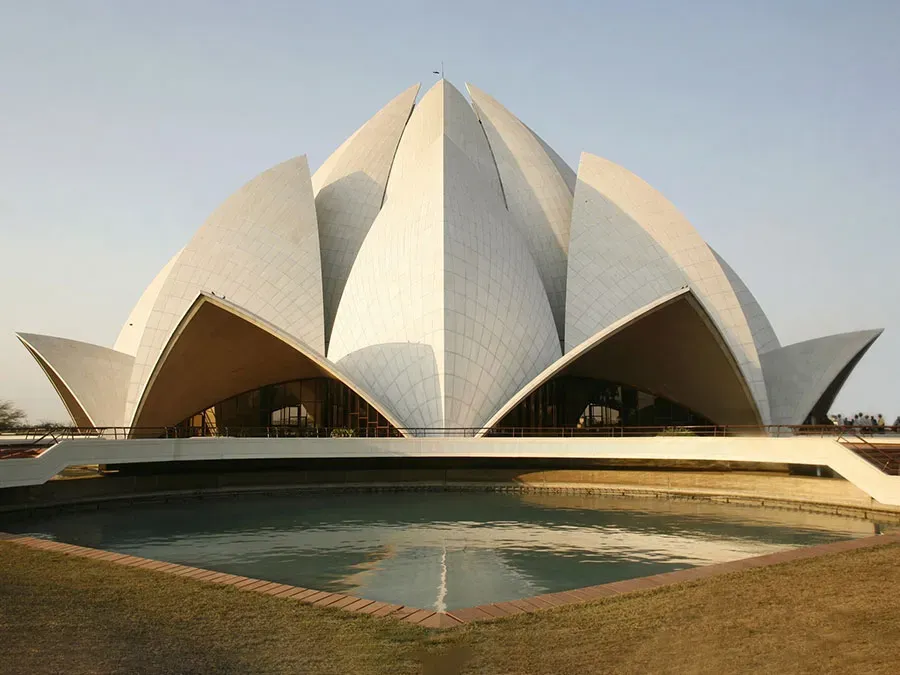5 Significant Buildings in Delhi
Delhi, a city rich in history and culture, is home to several iconic buildings. The Red Fort, a UNESCO World Heritage site, symbolizes India's rich past. Humayun's Tomb, an architectural precursor to the Taj Mahal, showcases Mughal architecture. Qutub Minar stands tall as a testament to Delhi's medieval history. India Gate, a war memorial, honors fallen soldiers. The Lotus Temple, known for its flower-like shape, serves as a Bahá'í House of Worship, welcoming people of all faiths.

1. India Gate
One of the most iconic monuments in Delhi, ''India Gate'' serves as a war memorial dedicated to the soldiers of the Indian Army who died in World War I and the Third Anglo-Afghan War. Designed by Sir Edwin Lutyens, this majestic arch stands 42 meters tall and is surrounded by lush lawns, making it a popular spot for both tourists and locals. The structure is adorned with the names of over 13,000 soldiers, showcasing India's rich history and sacrifice. At night, the ''India Gate'' is illuminated beautifully, drawing crowds who come to admire its grandeur.
2. Red Fort
The ''Red Fort'', or ''Lal Qila'', is a UNESCO World Heritage Site and a symbol of India's rich history. Built in the mid-17th century by Mughal Emperor Shah Jahan, the fort is an exquisite example of Mughal architecture, characterized by its massive red sandstone walls and intricate carvings. The fort complex houses several museums and beautiful gardens, and it is here that the Prime Minister of India hoists the national flag every year on Independence Day. The fort’s imposing structure and historical significance make it a must-visit for anyone exploring Delhi.
3. Qutub Minar
The ''Qutub Minar'' is the tallest brick minaret in the world, standing at an impressive height of 73 meters. This architectural marvel, built in the 12th century, is another UNESCO World Heritage Site. The minaret is part of the Qutub complex, which includes several other ancient monuments and ruins. The intricate carvings and inscriptions on the minaret showcase the artistry of the era. Visitors to the ''Qutub Minar'' can also explore the surrounding gardens and historical sites, making it a rich educational experience.
4. Humayun's Tomb
''Humayun's Tomb'' is a stunning example of Mughal architecture and is often considered a precursor to the ''Taj Mahal''. Built in the 16th century, this tomb is set in a beautiful garden and is the burial site of Mughal Emperor Humayun. The architecture features a mix of Persian and Indian styles, with a grand dome and intricate tile work. The tomb is surrounded by well-maintained gardens that offer a serene escape from the bustling city. This UNESCO World Heritage Site attracts architecture enthusiasts and history buffs alike.
5. Lotus Temple
The ''Lotus Temple'', known for its unique flower-like shape, is a Bahá'í House of Worship that has gained international acclaim for its stunning architecture. Completed in 1986, the temple is constructed from white marble and is surrounded by beautiful gardens. It serves as a place of meditation and reflection for people of all faiths, promoting the values of peace and unity. The ''Lotus Temple'' is open to visitors and has become a popular tourist attraction due to its architectural beauty and tranquil atmosphere.
Significance of These Buildings
Each of these structures not only represents architectural brilliance but also embodies the rich cultural heritage of India. They serve as reminders of the historical events and figures that shaped the nation. When visiting Delhi, these sites provide a glimpse into the past while showcasing the evolution of Indian architecture and artistry.
Table: Key Features of Significant Buildings in Delhi
| Building Name | Year of Construction | Architectural Style | UNESCO World Heritage Status |
|---|---|---|---|
| India Gate | 1921 | Arch | No |
| Red Fort | 1648 | Mughal | Yes |
| Qutub Minar | 1193 | Mughal | Yes |
| Humayun's Tomb | 1565 | Mughal | Yes |
| Lotus Temple | 1986 | Modern | No |
Conclusion
Exploring the ''significant buildings'' in Delhi offers invaluable insights into the rich tapestry of Indian history, culture, and architecture. From the colonial era to the Mughal empire, these landmarks stand as testaments to the artistic and cultural achievements of their times. Whether you are a history enthusiast, an architecture lover, or a casual traveler, these sites are essential stops during your visit to the capital city. Embrace the beauty and significance of these structures, and let them inspire your journey through the heart of India.












